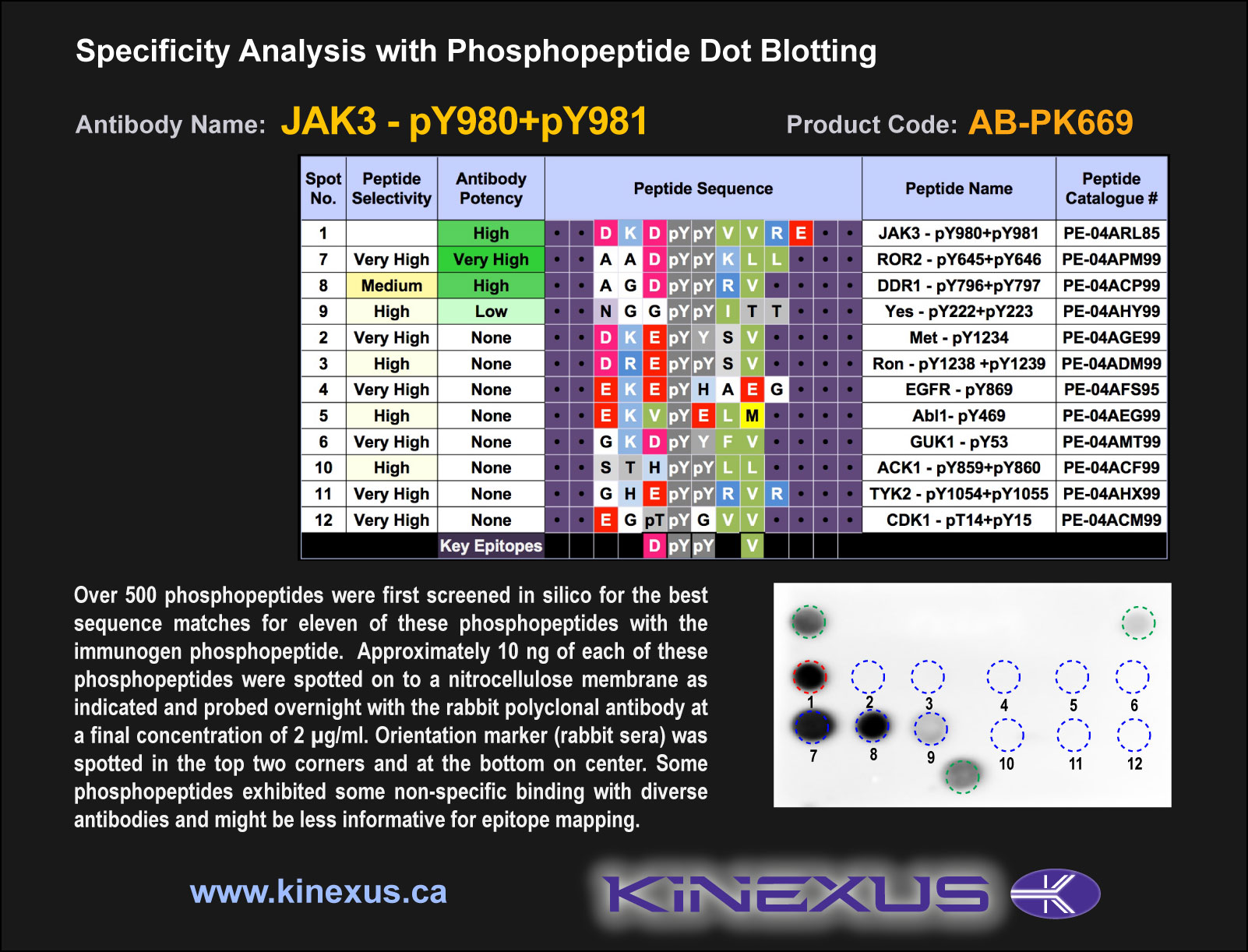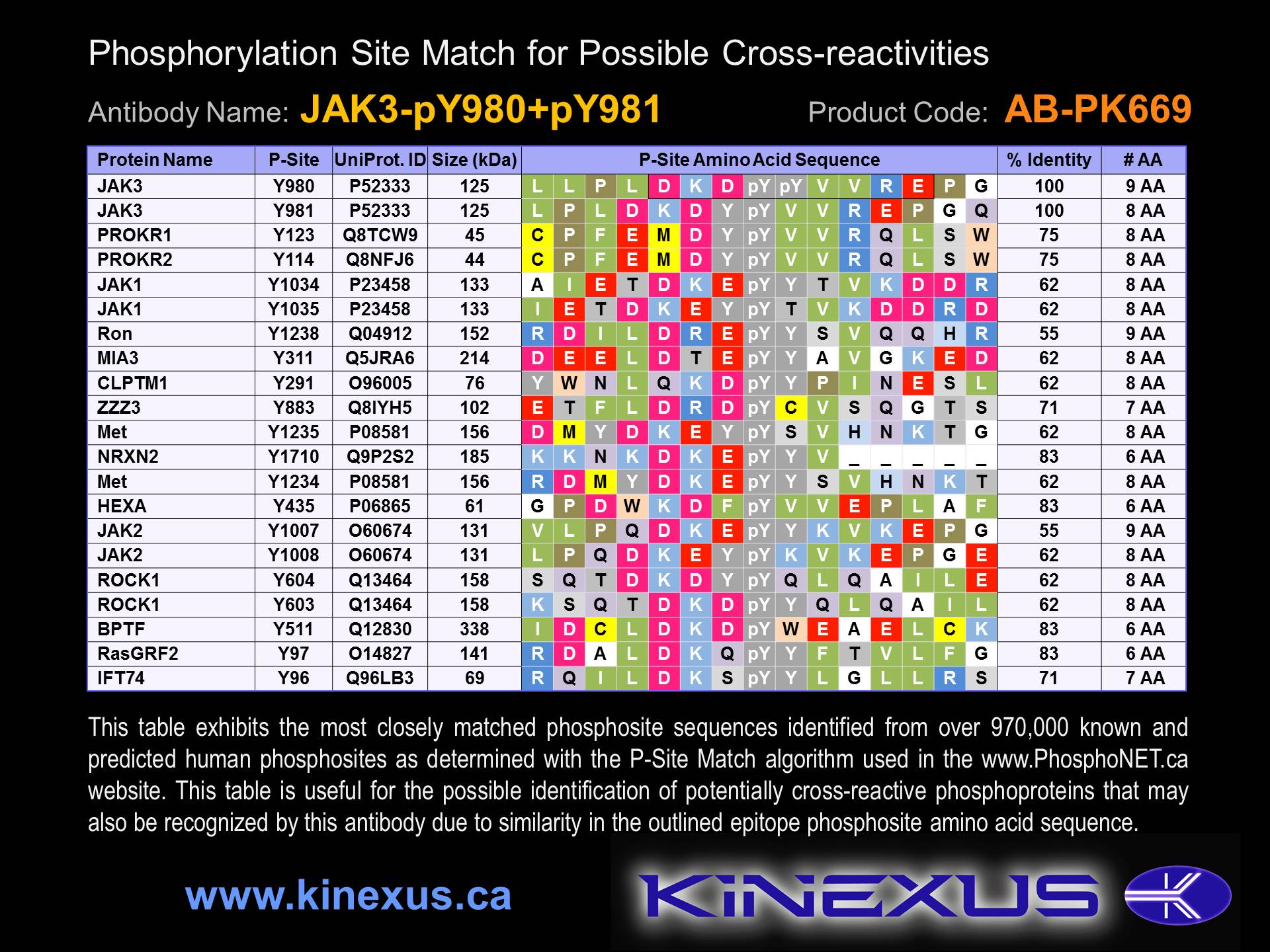Product Name: JAK3-pY980+pY981
Product Number: AB-PK669
| Size: | 25 µg | Price: | 89.00 | |
| $US |
Target Full Name: Janus protein-tyrosine kinase 3
Target Alias: JAK-3; JAK3_HUMAN; JAKL; Janus kinase 3; Kinase JAK3; Leukocyte janus kinase; LJAK; L-JAK; CCDS12366.1; ENSG00000105639
Product Type Specific: Protein kinase phosphosite-specific antibody
Antibody Code: PK669
Antibody Target Type: Phosphosite-specific
Antibody Phosphosite: Y980+Y981
Protein UniProt: P52333
Protein SigNET: P52333
Antibody Type: Polyclonal
Antibody Host Species: Rabbit
Target Alias: JAK-3; JAK3_HUMAN; JAKL; Janus kinase 3; Kinase JAK3; Leukocyte janus kinase; LJAK; L-JAK; CCDS12366.1; ENSG00000105639
Product Type Specific: Protein kinase phosphosite-specific antibody
Antibody Code: PK669
Antibody Target Type: Phosphosite-specific
Antibody Phosphosite: Y980+Y981
Protein UniProt: P52333
Protein SigNET: P52333
Antibody Type: Polyclonal
Antibody Host Species: Rabbit
Antibody Immunogen Source: Human JAK3 sequence peptide Cat. No.: PE-04ARL85
Antibody Immunogen Sequence: DKD(pY)(pY)VVRE(bA)C
Antibody Immunogen Description: Corresponds to amino acid residues D977 to E985; In protein kinase catalytic domain activation T-loop between subdomains VII and VIII.
Antibody Immunogen Sequence: DKD(pY)(pY)VVRE(bA)C
Antibody Immunogen Description: Corresponds to amino acid residues D977 to E985; In protein kinase catalytic domain activation T-loop between subdomains VII and VIII.
Production Method: The immunizing peptide was produced by solid phase synthesis on a multipep peptide synthesizer and purified by reverse-phase hplc chromatography. Purity was assessed by analytical hplc and the amino acid sequence confirmed by mass spectrometry analysis. This peptide was coupled to KLH prior to immunization into rabbits. New Zealand White rabbits were subcutaneously injected with KLH-coupled immunizing peptide every 4 weeks for 4 months. The sera from these animals was applied onto an agarose column to which the immunogen peptide was thio-linked. Antibody was eluted from the column with 0.1 M glycine, pH 2.5. Subsequently, the antibody solution was neutralized to pH 7.0 with saturated Tris.This antibody was also subject to negative purification over phosphotyrosine-agarose.
Antibody Modification: Unconjugated. Contact KInexus if you are interest in having the antibody biotinylated or coupled with fluorescent dyes.
Antibody Modification: Unconjugated. Contact KInexus if you are interest in having the antibody biotinylated or coupled with fluorescent dyes.
Antibody Concentration: 1 mg/ml
Storage Buffer: Phosphate buffered saline pH 7.4, 0.05% Thimerasol
Storage Conditions: For long term storage, keep frozen at -40°C or lower. Stock solution can be kept at +4°C for more than 3 months. Avoid repeated freeze-thaw cycles.
Product Use: Western blotting | Antibody microarray
Antibody Dilution Recommended: 2 µg/ml for immunoblotting
Antibody Potency: Medium immunoreactivity with immunogen peptide on dot blots. Strong immunoreactivity with recombinant human JAK3 on protein dot blots.
Antibody Species Reactivity: Human
Storage Buffer: Phosphate buffered saline pH 7.4, 0.05% Thimerasol
Storage Conditions: For long term storage, keep frozen at -40°C or lower. Stock solution can be kept at +4°C for more than 3 months. Avoid repeated freeze-thaw cycles.
Product Use: Western blotting | Antibody microarray
Antibody Dilution Recommended: 2 µg/ml for immunoblotting
Antibody Potency: Medium immunoreactivity with immunogen peptide on dot blots. Strong immunoreactivity with recombinant human JAK3 on protein dot blots.
Antibody Species Reactivity: Human
Antibody Positive Control: The observed molecular mass of the processed target protein on SDS-PAGE gels is reported to be around 110-125 kDa.
Antibody Specificity: High-very high
Antibody Cross Reactivity: Medium-weak immunoreactivity on protein dot blots with recombinant human JAK1, JAK2 and TYK2. No significant cross-reactive proteins detected in HepG2 and Jurkat cells and in sea star oocytes, except for a ~26 kDa cross-reactive protein in the HepG2 and Jurkat cells, and a ~40 kDa strongly cross-reactive protein in sea star oocytes.
Related Product 1: JAK3-pY980+pY981 blocking peptide
Related Product 2: JAK3-1 pan-specific antibody (Cat. No.: AB-NK086-2)
Related Product 3: JAK3-2 pan-specific antibody (Cat. No.: AB-NK086-3)
Antibody Specificity: High-very high
Antibody Cross Reactivity: Medium-weak immunoreactivity on protein dot blots with recombinant human JAK1, JAK2 and TYK2. No significant cross-reactive proteins detected in HepG2 and Jurkat cells and in sea star oocytes, except for a ~26 kDa cross-reactive protein in the HepG2 and Jurkat cells, and a ~40 kDa strongly cross-reactive protein in sea star oocytes.
Related Product 1: JAK3-pY980+pY981 blocking peptide
Related Product 2: JAK3-1 pan-specific antibody (Cat. No.: AB-NK086-2)
Related Product 3: JAK3-2 pan-specific antibody (Cat. No.: AB-NK086-3)
Related Product 4: JAK3-3 pan-specific antibody (Cat. No.: AB-NK086-4)
Related Product 5: JAK3Selectide - JAK3 protein kinase substrate peptide
Related Product 5: JAK3Selectide - JAK3 protein kinase substrate peptide
Scientific Background: JAK3 is a protein-tyrosine kinase of the TK group and JAKA family. Phosphorylation at T8, Y904 and Y980 increases phosphotransferase activity. Phosphorylation at Y939 also increases phosphotransferase activity and induces interaction with STAT5A. Phosphorylation at Y785 induces interaction with SH2-B-beta. Phosphorylation at Y981 inhibits phosphotransferase activity. It is involved in cytokine receptor-mediated intracellular signal transduction, including activation of an oncoprotein, PI3K. JAK3 may be an oncoprotein (OP). JAK3 mutations were commonly found in juvenile myelomonocytic leukemia from whole-exome sequencing studies from 13 individuals. JAK3 were hypothesized to be involved in the progression rather than the initiation of leukemia, and patients with mutated JAK3 were associated with poorer clinical results. Mutations in this gene have been found in blood, mouth, and ovarian cancers.
Figure 1. Epitope mapping of JAK3-pY980+pY981 antibody with similar phosphopeptides on dot blots.
Figure 2. Identification of phosphosites related to JAK3-pY980+pY981.
© Kinexus Bioinformatics Corporation 2017



